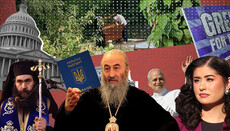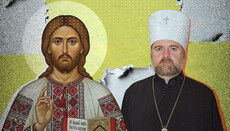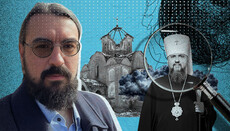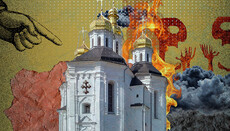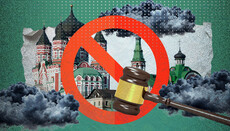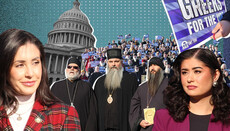A Uniate smile with a wicked squint: to 30th anniversary of the unia reset
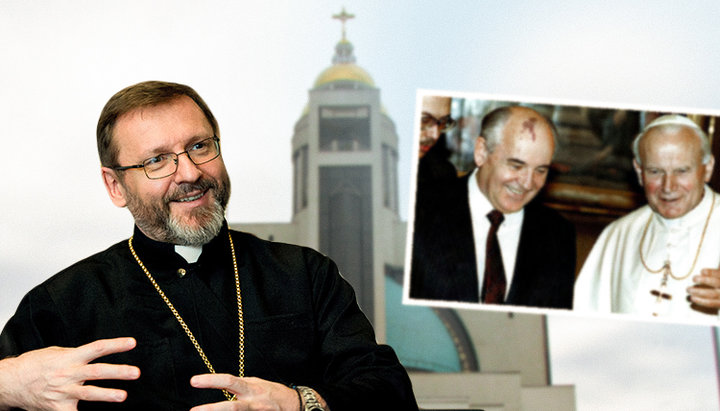
To the anniversary of the UGCC rebirth: about the meeting of Mikhail Gorbachev with the Pope in 1989, the revival of UGCC, and what came out of it.
The leader of the Ukrainian Uniates, "His Beatitude Supreme Archbishop of the UGCC", Sviatoslav Shevchuk, once again spoke about his claims to the ancient Orthodox shrine – the Cathedral of St. Sophia of Kiev, erected in the 11th century by the Kiev Grand Duke Yaroslav the Wise at the site of the victory over the Pechenegs in 1036.
Here, on the territory of St. Sophia, during 200 years (until 1918) there was a residence of the Kiev Metropolitans. With Jesuit hypocrisy, Shevchuk declared, "St. Sophia is our mother cathedral church, since all branches of Ukrainian Christianity are related to it." He reflected that the Kiev was called the second Jerusalem, but the Church of the Holy Sepulcher in Jerusalem does not belong to any of the faiths, but "is common Christian legacy". At the same time, again, he is deliberarely silent about the fact that Copts, Armenians, and Catholics would pray in the Church of the Holy Sepulcher even before breaking away from the one Church, whereas the Greek Catholics were born out of the notorious Brest Union of 1596, half a millennium after the erection of St. Sophia of Kiev.
Keeping pace with political and military demarche
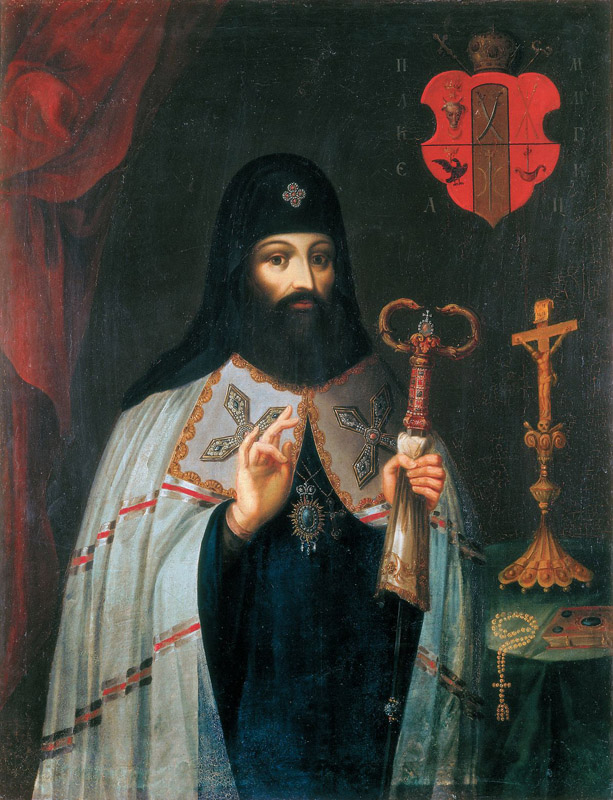
It is curious that all the outbursts of Greek Catholic expansion has always taken place in the atmosphere of political crises and upheavals with the participation of Western European, and now American “benefactors". Recall that the very birth of the union in the territory of present-day Ukraine was dictated by the policy of the Polish-Lithuanian Commonwealth, under whose yoke the Orthodoxy of the Ukrainian right bank was.
It is known what plight the right-bank Little Russia suffered after the adoption of the ill-fated Brest (Berestetskaya) church union in 1596, which gave rise to the current UGCC, according to which a number of traitor bishops led by Metropolitan Mikhail Rogoza became subordinate to the Pope. Historical documents indicate that for a quarter of the century, the Orthodox of the right-bank Little Russia under the rule of the Commonwealth, who did not accept the Union of Brest, were brutally persecuted, tormented and killed, and remained without a metropolitan.
The Orthodox Kiev Metropolis was restored only in 1620, when the Orthodox Kiev Metropolitans again began to bear the title of Metropolitan of Kiev and All Rus. In 1633, Metropolitan Peter Mogila was able to secure the recognition of the Orthodox Church by the state. By the way, in 1686, Patriarch Dionysius IV of Constantinople granted the very same “tomos” about the accession of the Kiev Metropolis to the Moscow Patriarchate (March 1686 - October 17, 1687), which the Synod of the Patriarchate of Constantinople considered to be illegal and “revoked” it on October 11, 2018. That resulted in the emergence in modern Ukraine of a new schismatic structure of the OCU, led by the schismatic and impostor Epiphany.
What the diaries of Peter Mogila tell about
In 2011, at the initiative of Kiev Theological Academy and Seminary, diary notes of St. Peter Mogila were published. In the preface of Metropolitan Vladimir (Sabodan; +2014) it is said that the diaries of Peter Mogila “are a unique work of the saint, as they not only illustrate various types of his activities in protecting Orthodoxy from heretic Uniates, but also open for us the inner world of this outstanding ecclesiastic, cultural and public actor."
"Handwritten notes" of His Eminence Peter is a unique monument to church history and literature. Thoroughly gathering information about the grace in the Kiev Pechersk monastery, Peter Mogila would not less zealously collect and enter into his book stories (and sometimes personal observations) about all the most remarkable miracles and events in the Orthodox Church (South-Rus, Moldavian-Vlachian and partly Greek), mainly paying attention to those that clearly showed the superiority of Orthodoxy over other religions and, moreover, exposed the inconsistency of the latter.”

There are many amazing fragments telling about how the Lord shamed the Uniates, who had seized almost the entire right-bank Ukraine, showing the naive people who would come to the Uniate services that in the "sacraments" of the Greek Catholics there is not only the grace of God, but they are blasphemous denigration of the Holy Spirit.
The Saint’s Diary contains legends revealing the errors of Catholicism, in particular, the doctrine of purgatory, which souls of the dead supposedly pass through and the introduction of a new calendar. Here is one of them:
“A certain influential mister, who converted to Catholicism on the advice of the priests, began to demand from Orthodox priests that they celebrate Christmas in a new style. He demanded permission to eat meat. When the priests resolutely refused, they were sent to prison. While in prison, the servants of God began to earnestly pray to the Lord: “May He not abandon the holy Orthodox faith in mock and reproach to the vile apostate, but soon take revenge on his evil mind.” Hardly had they finished praying as the proponent of the new style suddenly fell ill and died a few hours later.” (Over time, the Uniates "disguised" themselves as Orthodox and switched to the Julian calendar style – Auth.).
There is another entry – about the event, which showed the lack of grace of the Uniate Church. Saint Peter wrote that once, during the service performed by the Uniate Metropolitan Ipatius Potsey, wine, instead of being converted into the Blood of Christ, turned into ordinary water. There is a great deal of similar examples with dates, parishes, names of clergy and laity in the Notes.
Later, St. Peter Mogila entered into religious controversy and struggle with opponents of the paternal faith and the Orthodox Church. He wrote and published several religious polemical books, which matured and hatched for a long time. There is reason to believe that their appearance, as well as the creation of other works, was facilitated by his solitude in Goloseyevo – a small monastery built by the Saint in the outskirts of Kiev. Nowadays it is a famous monastery – Goloseyevo Hermitage.
With the collapse of the USSR
Let's go back to the twentieth century. The formation of independent Ukraine as a result of the collapse of the Soviet Union was also accompanied by massive seizures of Orthodox churches by Greek Catholics throughout Western Ukraine.
More precisely, it began on the eve of the collapse of the USSR, after Mikhail Gorbachev’s visit to the Vatican and a meeting with Pope John Paul II in November-December 1989, after which the Ukrainian Greek Catholic Church was legalized in the Ukrainian SSR, which ceased to exist after the end of World War II. The UGCC in every possible way supported the Hitler regime in the occupied territory of the Western Ukrainian lands, blessed the volunteers of the SS Galicia division, which fought as part of Nazi Germany.
In 1946, the UGCC council was held in Lvov under the chairmanship of Protopresbyter Gabriel Kostelnik, attended by Metropolitan Ioann (Sokolov) of Kiev and Galicia Patriarchal, an Exarch of the Russian Orthodox Church (+1968). The council proclaimed the historic act of liquidating the Union of Brest in 1596 and “returning the believing population of the Western Ukrainian lands from the many-century Uniate captivity to the Orthodox faith of its ancestors – the faith in which it was baptized and lived until 1596.”
Despite the tight Soviet control, the Uniate spirit lived and smoldered in the nationalist "catacombs" of Western Ukraine. It broke the silence after the collapse of the USSR.

One thing which happened 30 years is curious: on the eve of this landmark meeting of the Soviet president with the Pope of Rome, the Uniates who came out of the half-century underground in Ivano-Frankovsk took over the Resurrection Cathedral. It is not difficult to guess who had reported the upcoming significant act of the revival of the UGCC to nationalist groups, given the current overseas control of the religious situation in Ukraine. But the then Ivano-Frankovsk Archbishop Makariy (Svistun, +2007) locked in the cathedral in protest and declared an indefinite hunger strike, which was immediately announced to the world by "enemy voices" – the Voice of America radio station, Free Europe and the BBC.
The frightened (then still legitimate) future schismatic Metropolitan Filaret (Denisenko) took his gruel from Leonid Kravchuk, who at that time held a high position in the Politburo (Political Bureau) of the Ukrainian SSR being the head of the Ideological Department and the secretary of the Central Committee of the Communist Party of Ukraine.
Archbishop Makariy was removed from the chair, Greek Catholics settled in the seized cathedral, and many hundreds of Orthodox temples of Western Ukraine were grabbed by the Uniates in a short time in the Ivano-Frankovsk Eparchy. After a while, Filaret who fell through the patriarchal elections in the Russian Orthodox Church would initiate the granting of autocephaly to the Ukrainian Orthodox Church, the Greek Catholic expansion serving as a main argument of his rhetoric.
Today
It is significant that the construction of the new Patriarchal Council of Uniates in the capital of Ukraine began on the eve of the first Maidan in 2004, while the transfer of the patriarchal centre of the UGCC from Lvov to Kiev took place on the eve of Independence Day, August 21, 2005, under the rule of President Viktor Yushchenko.

After the second Maidan of 2014, during Petro Poroshenko’s rule, when fighting broke out in the east of the country, the Uniates wished to serve in the ancient Orthodox shrine – St. Sophia of Kiev (11th century), which was at the disposal of the state as a cultural and historical reserve.
To the regret of Sviatoslav Shevchuk, another attempt to get the right to serve in the ancient Orthodox church of Kievan Rus at the Annunciation holiday in 2019 went awry, although he had obtained the permission from the Ministry of Culture, which supervises the religious life of Ukraine. Under the pretext of urgent restoration works, the Greek Catholic liturgy at St. Sophia Cathedral was cancelled, apparently due to the upcoming presidential elections, which already heated the religious situation in Ukraine in view of the newly-minted Tomos and recognition of the schismatics from the UOC-KP and UAOC by the Patriarchate of Constantinople. They also wrote in the media that Filaret had personally addressed President Poroshenko with a demand not to allow Greek Catholics to access St. Sophia of Kiev, although the Uniates were invited there to the so-called Epiphany’s enthronement on February 3, 2019.
And now we can hear again the statements of the leader of the Uniates regarding the access to St. Sophia of Kiev for “all Christian denominations,” since this shrine is “national” and, in the words of the “supreme archbishop” of the Greek Catholics, “is our mother cathedral”.
The same arguments were repeatedly voiced by part of the political elite regarding the common use of the Pochaev and Kiev-Pechersk Lavras. The aspirations of the Uniates are now strongly backed by nationalist politicians of all ranks who consider the UGCC "the most patriotic church of Ukraine, its historical successor and a mouthpiece of the best national ideas". But history, as noted above, proves the opposite.
“We were split and estranged”: on Taras Shevcheko’s letter to Roman Catholics
It is known that the great Ukrainian poet Taras Shevchenko was a wonderful artist. Staying in Kiev, he would wander around its remote corners and outskirts, making pencil sketches of temples and monasteries, which later turned into watercolors.
One of them – “Askold's Grave” – depicts St. Nicholas temple at the cemetery in the tract, not far from the Kiev Pechersk Lavra, where, according to the legend, Prince Askold of Kiev was killed (the end of the 9th century). He could not know, of course, that more than a hundred years later, in February 1990, as a result of the above mentioned meeting in the Vatican of Mikhail Gorbachev with Pope John Paul II, the first church in Kiev to be transferred to the Greek Catholics (in Kiev, the there have never been Greek Catholic churches) will be this small St. Nicholas temple on Askold's Grave.
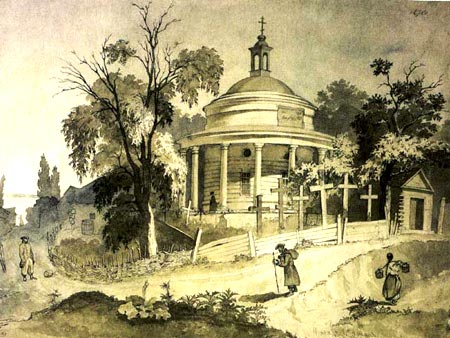
Exactly one year after the aforementioned watercolor painting was created, the poetic pen of Shevchenko gave birth to the lines of the famous poem “When we were Cossacks” (free translation - Ed.):
”When we were Cossacks
And there was no unia at all,
We used to enjoy our life!
...Until by the name of Christ
Catholic priests came and burnt
Our quiet paradise. And poured
Extensive sea of tears and blood,
And orphans by the name of Christ
Were murdered and crucified.
Cossacks are crestfallen
With their heads bent
like trodden grass.
Ukraine is crying and groaning!
Its people are falling dead beneath.
Torturers are ferocious,
And Catholic priests are crying out madly
“Te deum! Hallelujah!”
This is, my brothers,
How Catholic clergy separated
And made us alien to one another
Otherwise our life would never have changed
But stretch your hand to your Cossack brother
And take out your pure heart,
So that we could restore our quiet paradise
With the name of Christ.”
(Orsk fortress — 1850, Orenburg)
It seems that it would be advisable for everyone to read these poetic thoughts of the classic of Ukrainian poetry one more time, and especially for those who really want to establish peace in Ukraine, including the religious one.
